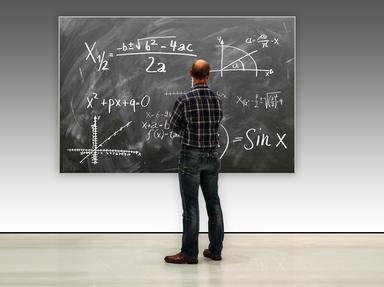Quiz Answer Key and Fun Facts
1. Different gases have different equations of states, which are the equations that interrelate pressure (P), volume (V), temperature (T) and number of moles (n) of the gases that we are interested in. The most famous one is the equation of state PV = nRT which is used to describe the behavior of ideal gases. What is the name given to the constant R?
2. As opposed to the ideal or perfect gases, real gases do not obey the equation of state PV = nRT. Real gases may obey more complicated equations of states which involve more parameters and constants, for example, the famous van der Waals equation, [P+(an)^2/V^2][V-nb]=nRT, where P = pressure, V = volume, n = number of moles, R = proportionality constant, T = temperature, a & b = van der Waals constants. Nonetheless, real gases DO obey the ideal gases' equation of state under certain conditions. What are the criteria?
3. The compression factor, Z is a convenient way to measure the degree of deviation of a real gas from ideal behavior. The formula is given by Z = V1/V2, where V1 is the volume that is occupied by 1 mole of the real gas, while V2 is the volume that is occupied by an ideal gas, at the same temperature and pressure. When Z = 1, we say that the gas is behaving ideally. However, if we get the value of Z to be less than 1, we can say that the _____ forces are dominant in the sample of real gas. What goes in the blank? Attractive or repulsive? (Hint: When attractive forces are dominant, the gas can be compressed more easily. On the contrary, the gas is more difficult to be compressed when repulsive forces are dominant)
4. By using the ideal gases as a model, scientists have proposed the kinetic theory of gases. This theory is based on 3 assumptions. Which of the following is NOT one of them?
5. The condensation of gas into liquid form is possible because of the existence of intermolecular attractive forces within the gas molecules. Now, if we do some differentiation to the equation of state (pressure, P with respect to volume, V), we may obtain an inflection point. At this critical (inflection) point, we can know the critical temperature of the gas. The critical temperature is the _____ temperature where the condensation of gas is possible. What goes in the blank? Lowest or highest? (Hint: Keep in mind that the gas will only condense at very low temperature)
6. The Maxwell distribution of speeds of gas molecules are given by a very complicated formula. If the graph F(v) against speed is plotted, we will get an unsymmetrical bell shape curve on the first (upper right) quadrant. Apart from the molecular mass of the gas, what other factor will influence the shape of the graph?
7. From the Maxwell distribution graph, we can have 3 types of speeds. The first one is the most probable speed, V1, which is the maximum speed which occurs at the peak of the graph. The second one is the mean speed, V2. As the name implies, V2 is the average speed of all the gas molecules. Last but not least is the root mean square speed, V3. Their formulae are given by V1 = surd (2RT/M), V2 = surd (8RT/pi M) and V3 = surd (3RT/M), where R = proportionality constant, T = temperature, M = molar mass. Which of the following is the CORRECT inequality that relates these 3 speeds? (Hint: compare the numerical terms in the three formulae, you can cancel out all the variables)
8. The collision theory is very important because it affects the rate of chemical reaction. Generally, there are 2 types of collision, namely collision of similar molecules and of different molecules. Two important terms involved here are collision frequency and collision density. The former is the number of collisions made by one gas molecule per unit time, while the latter is defined as the number of collisions made by ALL of the gas molecules per unit volume per unit time. Assume all the gas are contained in separate container of the same volume and temperature, which of the following gas will have the greatest collision frequency? (Note that hydrogen is lighter than oxygen)
9. You might have heard of the term "viscosity" of liquid, where a liquid with higher viscosity, such as oil, will move or travel slower than another liquid of lower viscosity, such as vinegar. Well, viscosity applies to gases as well. It is defined as the migration of linear momentum down a velocity gradient. What is the unit for viscosity?
10. Approximately 21% of the air around us at the sea level is oxygen, O2 while 0.04% is carbon dioxide, CO2. Which of the following gases constitutes 78% of the air?
Source: Author
Matthew_07
This quiz was reviewed by FunTrivia editor
crisw before going online.
Any errors found in FunTrivia content are routinely corrected through our feedback system.

